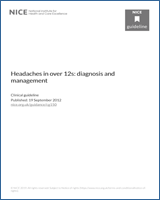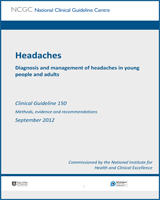Assessment and diagnosis:
Indications for consideration of additional investigation | For young people and adults with HIV presenting with new onset headache, how common are serious intracranial abnormalities? |
|
| For young people and adults with a history of malignancy presenting with new onset headache, how common are serious intracranial abnormalities? |
|
| For young people and adults presenting with early morning headache or new onset frequent headache that lasts for more than one month, how common are serious intracranial abnormalities? |
|
Assessment and diagnosis:
Identifying people with primary headache | What is the accuracy of case finding questionnaires for diagnosing primary headache disorders and medication overuse headache? |
|
Assessment and diagnosis:
Headache diaries for the diagnosis and management of primary headaches and medication overuse headache | What is the clinical effectiveness of using diaries for the diagnosis of people with suspected primary headaches and medication overuse headache? |
Number of people correctly diagnosed Positive predictive value Negative predictive value Sensitivity Specificity.
|
| What is the clinical effectiveness, and patients’ and practitioners’ experience, of using diaries for the management of people with primary headaches and medication overuse headache? |
|
Assessment and diagnosis:
Diagnosis of primary headaches and medication overuse headache | For young people and adults with headache, what are the key diagnostic features of the following headaches:
Migraine with or without aura Menstrual related migraine Chronic migraine Tension-type headache Cluster headache Medication overuse headache.
| N/A |
Assessment and diagnosis:
The role of imaging in diagnosis and management of primary headaches | Should young people and adults with suspected primary headaches be imaged to rule out serious pathology? | Percent with the following serious abnormalities:
|
| For people with the following primary headaches (migraine with or without aura, menstrual related migraine, chronic migraine, tension type headache, cluster headache), what is the clinical evidence and cost-effectiveness of imaging as a management strategy? |
Resource use including GP consultation, A&E attendance, investigations and referral to secondary care Change in headache frequency and intensity (with e.g. headache impact test or migraine disability assessment test) Percentage responders with 25%, 50% and 75% reduction in baseline headache frequency Change in frequency of acute medication use Change in anxiety and depression (e.g. HAD) Change in health related quality of life (e.g. SF-36 or EuroQoL) Incidental radiological findings.
|
Management:
Information and support | What information and support do patients with primary headaches say they want? |
|
Management:
Acute pharmacological treatment of tension type headache | In people with tension type headache, what is the clinical evidence and cost-effectiveness for acute pharmacological treatment with: aspirin, NSAIDs, opioids and paracetamol? |
Time to freedom from pain Headache response at up to 2 hours Pain free at 2 hours Pain intensity difference Sustained headache response at 24 hours Sustained freedom from pain at 24 hours Functional health status and health related quality of life (e.g. SF-36 or EuroQoL) Incidence of serious adverse events.
|
Management:
Acute pharmacological treatment of migraine | In people with migraine with or without aura, what is the clinical evidence and cost-effectiveness for acute pharmacological treatment with: antiemetics, aspirin, NSAIDs, opioids, paracetamol, triptans, ergots and corticosteroids? |
Time to freedom from pain Headache response at up to 2 hours Freedom from pain at up to 2 hours Sustained headache response at 24 hours Sustained freedom from pain at 24 hours Headache specific quality of life Functional health status and health related quality of life Incidence of serious adverse events.
|
Management:
Acute pharmacological treatment of cluster headache | In people with cluster headache, what is the clinical evidence and cost-effectiveness for acute pharmacological treatment with: aspirin, paracetamol, oxygen, triptans, ergots, NSAIDs and opioids? |
Time to freedom from pain Headache response up to 2 hours Reduction in pain at 30 minutes Functional health status and health related quality of life Incidence of serious adverse events.
|
Management:
Prophylactic pharmacological treatment of tension type headache | In people with tension type headache, what is the clinical evidence and cost-effectiveness for prophylactic pharmacological treatment with: ACE inhibitors and angiotensin II receptor antagonists (ARBs), antidepressants (SNRIs, SSRIs, tricyclics), beta blockers and antiepileptics? |
Change in patient-reported headache days, frequency and intensity Functional health status and health-related quality of life Responder rate Headache specific quality of life Resource use Use of acute pharmacological treatment Incidence of serious adverse events.
|
Management:
Prophylactic pharmacological treatment of migraine | In migraine with or without aura and chronic migraine, what is the clinical evidence and cost-effectiveness for prophylactic pharmacological treatment with: ACE inhibitors and angiotensin II receptor antagonists (ARBs), antidepressants (SNRIs, SSRIs, tricyclics), beta blockers, calcium channel blockers, antiepileptics and other serotonergic modulators? |
Change in patient-reported headache days, frequency and intensity Responder rate Functional health status and health-related quality of life Headache specific quality of life Resource use Use of acute pharmacological treatment Incidence of serious adverse events.
|
Management:
Prophylactic pharmacological treatment of menstrual migraine | In people with pure menstrual and menstrual related migraine, what is the clinical evidence and cost-effectiveness for prophylactic pharmacological treatment with: ACE inhibitors and angiotensin II receptor antagonists, antidepressants (SNRIs, SSRIs, tricyclics), beta blockers, calcium channel blockers, antiepileptics, triptans, other serotonergic modulators, NSAIDs and hormonal therapy (contraceptives)? |
Change in patient-reported headache days, frequency and intensity Responder rate Functional health status and health-related quality of life Headache specific quality of life Resource use Use of acute pharmacological treatment Incidence of serious adverse events.
|
Management:
Prophylactic pharmacological treatment of cluster headache | In people with cluster headache, what is the clinical evidence and cost-effectiveness for prophylactic pharmacological treatment with: calcium channel blockers, corticosteroids, lithium, melatonin, antiepileptics, triptans and other serotonergic modulators? |
Change in patient-reported headache days, frequency and intensity Responder rate Functional health status and health-related quality of life Headache specific quality of life Resource use Use of acute pharmacological treatment Incidence of serious adverse events.
|
Management:
Prophylactic non-pharmacological management of primary headaches with acupuncture | For people with primary headaches, what is the clinical evidence and cost-effectiveness of management with acupuncture? |
Change in patient-reported headache days, frequency and intensity Responder rate Functional health status and health-related quality of life Headache specific quality of life Resource use, including GP consultation, A&E attendance, investigations and referral to secondary care Use of acute pharmacological treatment Incidence of serious adverse events.
|
Management:
Prophylactic non-pharmacological management of primary headaches with manual therapies | For people with primary headaches, what is the clinical evidence and cost-effectiveness of non-pharmacological management with manual therapies? |
Change in patient-reported headache days, frequency and intensity Responder rate Functional health status and health-related quality of life Headache specific quality of life Resource use Use of acute pharmacological treatment Incidence of serious adverse events.
|
Management:
Prophylactic non-pharmacological management of primary headaches with psychological therapies | For people with primary headaches, what is the clinical evidence and cost-effectiveness of non-pharmacological management with psychological therapies? |
Change in patient-reported headache days, frequency and intensity Responder rate Functional health status and health-related quality of life Headache specific quality of life Resource use Use of acute pharmacological treatment Incidence of serious adverse events.
|
Management:
Prophylactic non-pharmacological management of primary headaches with herbal remedies and dietary supplements | For people with primary headaches, what is the clinical evidence and cost-effectiveness of management with herbal remedies? |
Change in patient-reported headache days, frequency and intensity Responder rate Functional health status and health-related quality of life Headache specific quality of life Resource use, including GP consultation, A&E attendance, investigations and referral to secondary care Use of acute pharmacological treatment Incidence of serious adverse events.
|
| For people with primary headaches, what is the clinical evidence and cost-effectiveness of management with dietary supplements (e.g. magnesium, vitamin B12, coenzyme Q10 and riboflavin (vitamin B2)). |
Change in patient-reported headache days, frequency and intensity Responder rate Functional health status and health-related quality of life Headache specific quality of life Resource use Use of acute pharmacological treatment Incidence of serious adverse events.
|
Management:
Prophylactic non-pharmacological management of primary headaches with exercise | For people with primary headaches, what is the clinical evidence and cost-effectiveness of non-pharmacological management with exercise programmes? |
Change in patient-reported headache days, frequency and intensity Responder rate Functional health status and health-related quality of life Headache specific quality of life Resource use Use of acute pharmacological treatment Incidence of serious adverse events.
|
Management:
Prophylactic non-pharmacological management of primary headaches with education and self-management | For people with primary headaches, what is the clinical evidence and cost-effectiveness of non-pharmacological management with education and self-management programmes? |
Change in patient-reported headache days, frequency and intensity Responder rate Functional health status and health-related quality of life Headache specific quality of life Resource use Use of acute pharmacological treatment Patient’s perception of the usefulness of programmes.
|
Management:
Medication overuse headache | What is the clinical evidence and cost-effectiveness of withdrawal strategies (of abortive treatments), psychological therapies, corticosteroids and NSAIDs for the treatment of probable medication overuse headache (MOH)? |
Change in acute medication use (up to 3 months) Relapse back to MOH Responder rate (proportion who no longer have probable MOH) Change in patient reported headache days, frequency and intensity Headache specific quality of life Resource use Functional health status and health related quality of life.
|
Management during pregnancy and contraceptive use:
Management of primary headaches during pregnancy | What is the evidence for adverse fetal events in females with primary headaches during pregnancy using triptans? |
|
| What is the evidence for adverse fetal events in females using oxygen or verapamil during pregnancy? |
|
Management during pregnancy and contraceptive use:
Combined hormonal contraception use in girls and women with migraine | What risks are associated with use of hormonal contraception in females aged 12 or over with migraine? |
|



